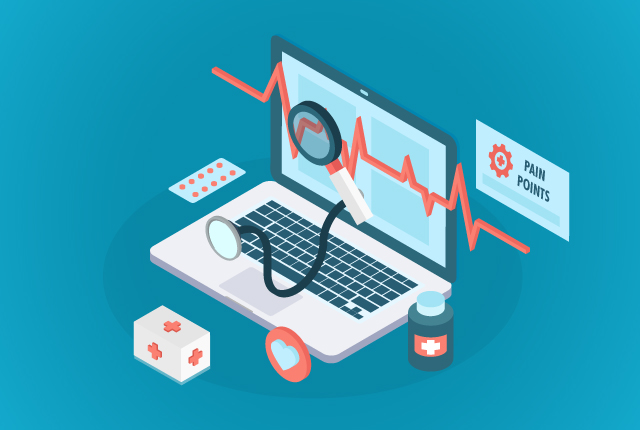
Welcome to the final installment of our healthcare software testing blog series, where we explore the unique pain points of testing in this space and uncover the solutions that QA teams can provide. In our last posts, we looked at challenges related to domain expertise, data migration, healthcare standards, integration testing, security testing, and performance testing.
Now, let’s shift our focus to the rest of the challenges:
Medical Device Testing
Medical devices need to follow strategized testing techniques. Failure to achieve compliance with regulations and compatibility makes the system nasty, affecting the overall performance qualities of the system in use and may lead to device failure.
Pain Points/Examples
- Incorrect Heart Rate: A simple Fitbit step/heartbeat tracker displaying a false heart rate can raise anxiety for individuals tracking it.
- Security Breaches: If password protection is a broken piece of code/cyber-attack carried out on a medical data storage device tied to a centralized system, it may lead to the loss of critical information.
- Device and Network Compatibility: These can be significant areas of concern when dealing with the testing of medical devices.
Solution
- Practice error handling testing techniques to ensure edge case coverage, as medical devices must be checked/verified under all circumstances like power failure, internal issues, and fluctuation.
- Practice authentication validation, audit trail verification (i.e., unauthorized access checks), and multi-platform testing.
- Validation of network switching and compatibility with the corresponding listed devices.
Artificial Intelligence/Machine Learning model validation
With emerging trends, the healthcare sector is demanding more quality healthcare services, where undoubtedly AI and ML come into the picture due to the growing complexities of data, systems, and higher costs. However, issues like ensuring transparency and explainability in training models may arise, as the data used to train AI may be biased.
Uncertainty in the AI validation process as any misleading/inevitable data may lead to risking life and be a towering cost, which can further lead to significant failures and harm the brand image.
ML models help in identifying issues that affect streamlining concepts and reporting results so that, based on outcomes, treatments can be customized.
Pain Points/Examples
- Image Recognition System: AI models for image recognition can be biased based on the data fed to the system. Hence, human intervention and verification are required.
- LLM Hallucinations: LLM (Large Language Models) powered apps sometimes generate possible yet unverified/incorrect responses based on predictions from insufficient or inaccurate training data. This leads to reputational risk to the business.
- Predictive Analysis: Few systems/algorithms are trained to learn from the input data received in the system by comparing it to data generated during the previous phase/stage of the cycle or while it was in a maintenance state. Hence, predictive analysis needs to be more foolproof and requires human intelligence.
Solutions
- Scalability of existing healthcare app data shall be considered where unbiased ML-trained models/AI-based algorithms must be tested to provide the potential to derive any data-driven support required with automated insights.
- Debugging and ensuring that the LLM models are trained with sufficient, unbiased, and well-balanced data appropriate for each use case.
- Real-world scenarios should be tested for validation and verification of AI/ML models. All permutations and combinations.
Master Data Management
Volumes of patient data are shared between hospitals and physicians, so the chances of redundant data are high. De-duplication of this data is mandatory to make the systems function without snags or performance breakdowns. The testing of such re-organized data can lead to challenges like these:
Pain Points/Examples
Consider a healthcare app module that stores and manages patient records/data digitally and does not follow regulatory compliances/standards.
- Data Privacy: Respecting patient privacy is a significant concern, so failure to use de-anonymized data may lead to leakage of important information.
- Data Synchronization: Testing data synchronization is also required, as a minor miss can lead to inaccurate results.
- Data Retention: Cleaning and retaining data is a concern due to bulk data processing, including the cost and time involved.
Solutions
Having a team of QA engineers who can efficiently work on validating the pre and post-merge of master data will help minimize the challenges above. Some key areas that QA professionals should focus on:
- Efficiently seeding bulk data in a single go using different input methods.
- Verification of data standardization process that adheres to compliance.
- Auditing de-duplicated data, including field-level verification.
- Validating the realignment of dependent or linked objects and transactional data.
- Know different input methods for bulk data seeding and proficiency in master data management tools.
User Experience and Next-Generation Interfaces
Today, the interfaces used by customers are varied and diverse. Next-generation interfaces like AI-based chatbots and advanced technologies like Voice Assistants and Natural Language Processing (NLP), Augmented Reality (AR) and Virtual Reality (VR), and Gesture Emotion Recognition are the new wave in the digital healthcare space. QA engineers must be equally comfortable with these as they are with graphical user interfaces (GUI). Verifying latency, accuracy, and a proper user experience is vital.
Pain Points/Examples
- In gesture control, the app might not respond accurately/at the correct time or interfere with other ongoing application processes.
- Uncertainty of user conversation
- Chatbot intelligence is not being questioned, and security is being compromised.
- Failure to establish testing priorities.
Solutions
- Identify and test edge cases or uncommon scenarios that might lead to unexpected behavior or errors in the interface-simulated real-world scenarios.
- Conduct security audits to identify vulnerabilities and ensure the interface handles sensitive data securely and complies with privacy regulations.
- Ensure the interface is accessible to users with disabilities, adhering to accessibility standards and guidelines.
- Ensure implementation of comprehensive test scenarios creation and involve end-users in the testing process.
- Understand the end user needs and expectations as each interface has its work pattern, so collaboration with developers and designers becomes essential.
Conclusion
While performing healthcare software testing, the engineer must comply with the data security and privacy guidelines, and they should never forget that any unexpected information appearing on a patient’s report can have life-altering consequences. In this space, the stakes are high, and engineers must never forget that the quality and predictability of the application are closely tied to the health of the customer and the healthcare organization's success.


